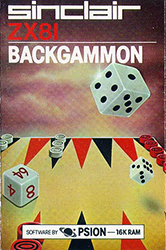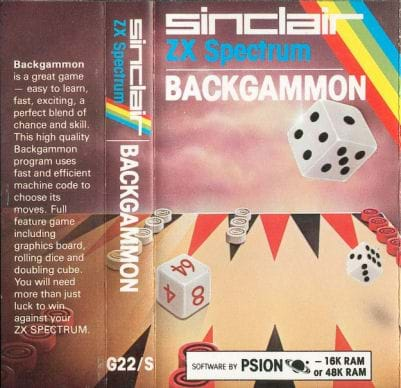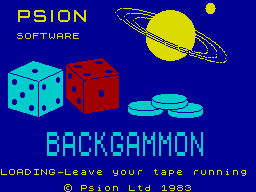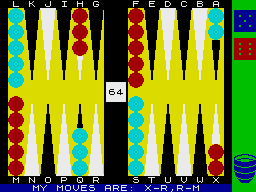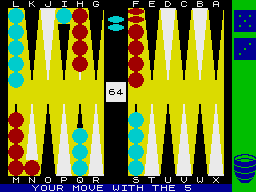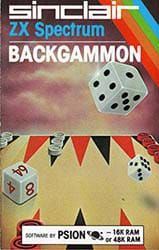
- Catalogue No :
- Original Price : £5.95
- Developer : Psion
- Computer : ZX Spectrum ZX81
- Number Of Players : 1
- Genre : Board Game
- Keyboard Controls : Yes
- Joystick Control : No
Backgammon is a great game - easy to learn, fast, exciting, a perfect blend of chance and skill. This high quality Backgammon program uses fast and efficient machine code to choose its moves. Full feature game including graphics board, rolling dice and rolling cube. You will need more than just luck to win against your ZX SPECTRUM.
Backgammon is a 3000 year old game of chance and skill for two people -or in this case between a computer and a person.The game is played on a special backgammon board which pieces(also called 'men' or 'stones'), rather like draught pieces, and a pair of dice.A comparatively modern addition to the games is the doubling cube which gives the game an extra dimension and enhances the opportunity of using skill rather than just luck to defeat one's opponent.
The Backgammon Board:
The board consists of 24 points which are divided into four 'tables' each consisting of 6 points.The points are represented by alternative white and black triangles and are denoted by the 24 letters from A to X in the program.As the board is displayed, the black or red side is at the top and the white or light blue side is at the bottom. The ZX SPECTRUM plays from the top side and owns the red men and you play on the bottom side using the light blue men. The thick vertical black area which divides the board is called the bar. The two tables to the right of the bar are the inner tables and the two tables on the left are the outer tables.
The Rules of Backgammon:
The Play:
Your men play with the alphabet (from right to left at the top and from left to right at the bottom) and the ZX SPECTRUM'S red men move in the opposite direction.
The Objective:
Your objective is to move all your men into your inner table (points S to X) and then to bear them off the table before the ZX SPECTRUM does the same thing with his men and his inner table(points A to F).
The Move:
You and the ZX SPECTRUM take turns to roll the dice and move one or more men the precice number of spaces indicated by the dice. Each die must be played individually and each move must be legal. If a double is thrown then the value of the throw is doubled and four separate and individual moves must be made.If you can play only one die or only the other then you must play the higher throw, and you msu play both throws if possible.
Blocking:
If a player has two or more men on a point then that point is blocked to his opponent.His opponent may not land on that point, even temporarily.
Hitting:
If a player has only one man on a point (a blot) then his opponent can land on that point and send the man to the bar - this is called a hit.
The Bar:
If a player has one or more men on the bar then he must move them off the bar before he makes any other play.If you are on the bar then you will come in (unless you are blocked) as if you had men on a point immediately to the right of point A. Similarly the ZX SPECTRUM will come off the bar as if he had men on a point immediately to the right of point X. A player who cannot get off the bar may lose a part or all of his turn.
Bearing Off:
When a player has all his men in his inner table then he can start bearing off.If a throw bears off exactly, i.e.the man would land exactly one point past the last point then that man can be borne off. A man can also be borne off with a throw that is too high provided that that man is the furthest man out.
The Doubling Cube:
At the beginning of the game, the doubling cube is at the centre of the bar and shows either 64(which really indicates 1) or 2.While the doubling cube is so placed, either player has the right to offer his opponent a double.A player who wishes to offer a double (because he believes that he is likely to win the game) must make the offer at the start of his own turn, before rolling his dice. If his opponent declines this offer then he loses the game and the offerer wins the number of points displayed on the doubling cube before the offer was made. If the offer is accepted then the doubling cube is turned to the next highest number and placed nearest to the player who accepted the double.That player then has charge of the cube and only he can subsequently offer another double (which he might want to do if the game where to turn in his favour) in which case the doubling cube and the right to offer a double would change hands.
Scoring:
The first player to bear off all his pieces wins at least the number of points displayed on the doubling cube.If the loser has not borne off any men but does not have a man on the bar or on his opponent's home table then the win is a gammon and the winner collects double the number of points shown on the doubling cube. If the loser still has a man on the bar or on his opponent's inner table then the win is a backgammon and the winner collects three times the number of points shown on the doubling cube.
Playing the ZX Spectrum:
If you are not familiar with the rules of Backgammon, you can learn them as you play since the program will not let you make an illegal move and it will also tell you why a move is illegal.
After loading the program, you will be asked a couple of questions. First you will be asked for the level of ZX SPECTRUM play: press 1 to 4, where 4 is the hardest level.You will then be asked whether you wish to enter your own die throws manually.Press Y for YES, or N for NO.Press Y for YES only if you are convinced the programme is cheating or you with to play against another computer (see bottom for the randomness of the dice).
Having set the level of play the score will be displayed along with the current level of ZX SPECTRUM play.You will be given an opportunity to go back to the first page(press Y for yes) or play a game (press N for no). If you do not respond within 40 seconds the program will enter an automatic demonstration mode.
Once you have pressed N, the Backgammon table will be displayed and the dice will roll to decide who will play first.The doubling cube in the middle of the bar is set at 64 which really indicates 1(this may seem strange but traditionally there is no 1 on a doubling cube and 64 is used to indicate both 1 and 64).If the rolling dice setting in a double the stake(as indicated by the doubling cube) will be doubled to 2 and the dice will be rolled repeatedly until a non-double is thrown.Your die is on the top: whoever has the highest throw plays first with that same throw.
When it is your modve and the dice have settled, the program will prompt you with the message.
YOUR MOVE WITH THE n where n is the number on one of the die. You reply by entering a single letter which falls into three categories:
1 - Enter A to X to move a man from that point.
2 - Enter Y to move a man off the bar.
3 - Enter Z to play the other die first.
Provided that your move is legal, according to the riles of Backgammon, the appropriate man will be moved to its new point.If your move is illegal, a message informing you why the move is illegal will be flashed up and you will be asked for your move again.If you cannot move, the program will tell you so and then pass to the ZX SPECTRUM'S turn.
When you have pressed the key or keys to make your move(s), you may still change your mind by deleting and re - entering your moves.To replay your moves, press the DELETE key('0') on your Spectrum.This will return your man to its previous position.You may then press a key to make a new move. When you are satisfied with your moves, press ENTER to complete your moves and allow the Spectrum to make its moves.
After the Spectrum has played, you may doule by pressing the key D. If you do not wish to double, press ENTER to roll your dice.If the ZX SPECTRUM accepts the offer of a double, the number the number on the doubling cube will double and the cube will move over to the ZX SPECTRUM'S side. Pressing D has no special effect if the ZX SPECTRUM has charge of the doubling cube.
If the ZX SPECTRUM does have charge of the doubling cube, then it may offer you a double before it rolls the dice with the prompt:
DOUBLE OFFERED -Y TO ACCEPT
If you enter Y to accept, then the number on the doubling cube will double and the cube will move over to your side. If you press any other key to reject, the Spectrum will ask for confirmation that you are resigning. Press R to resign.The game will terminate with the ZX SPECTRUM winning the current stake as displayed on the doubling cube.
Backgammon is a game of both skill and luck.It is not unusual for the less skillful player to win the odd game by having more luck.If you want to compare your play with that of the ZX SPECTRUM you should play a series of games for points.You would normally play a reasonable number of games if you play 'first to eleven', i.e.the winner is the first to accumulate eleven points.
At any stage of the game when it is you turn to move, you may ask the Spectrum to recommend a move by pressing the key '1'.
